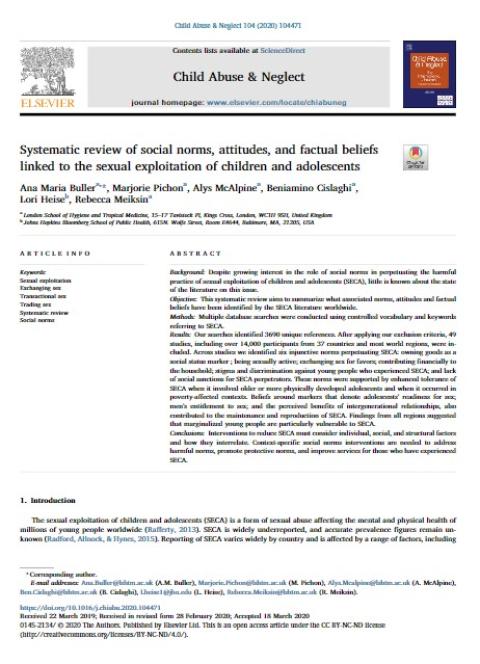- Journal article
- 6 mai 2020
Systematic review of social norms, attitudes, and factual beliefs linked to the sexual exploitation of children and adolescents
- Published by: Child Abuse and Neglect

Abstract
Background
Despite growing interest in the role of social norms in perpetuating the harmful practice of sexual exploitation of children and adolescents (SECA), little is known about the state of the literature on this issue.
Objective
This systematic review aims to summarize what associated norms, attitudes and factual beliefs have been identified by the SECA literature worldwide.
Methods
Multiple database searches were conducted using controlled vocabulary and keywords referring to SECA.
Results
Our searches identified 3690 unique references. After applying our exclusion criteria, 49 studies, including over 14,000 participants from 37 countries and most world regions, were included. Across studies we identified six injunctive norms perpetuating SECA: owning goods as a social status marker ; being sexually active; exchanging sex for favors; contributing financially to the household; stigma and discrimination against young people who experienced SECA; and lack of social sanctions for SECA perpetrators. These norms were supported by enhanced tolerance of SECA when it involved older or more physically developed adolescents and when it occurred in poverty-affected contexts. Beliefs around markers that denote adolescents’ readiness for sex; men’s entitlement to sex; and the perceived benefits of intergenerational relationships, also contributed to the maintenance and reproduction of SECA. Findings from all regions suggested that marginalized young people are particularly vulnerable to SECA.
Conclusions
Interventions to reduce SECA must consider individual, social, and structural factors and how they interrelate. Context-specific social norms interventions are needed to address harmful norms, promote protective norms, and improve services for those who have experienced SECA.
- Tags:
- Gender-based violence
- Countries / Regions:
- Global
Related resources
Blog
14 avril 2025

Report
5 mars 2025

Blog
10 février 2025
